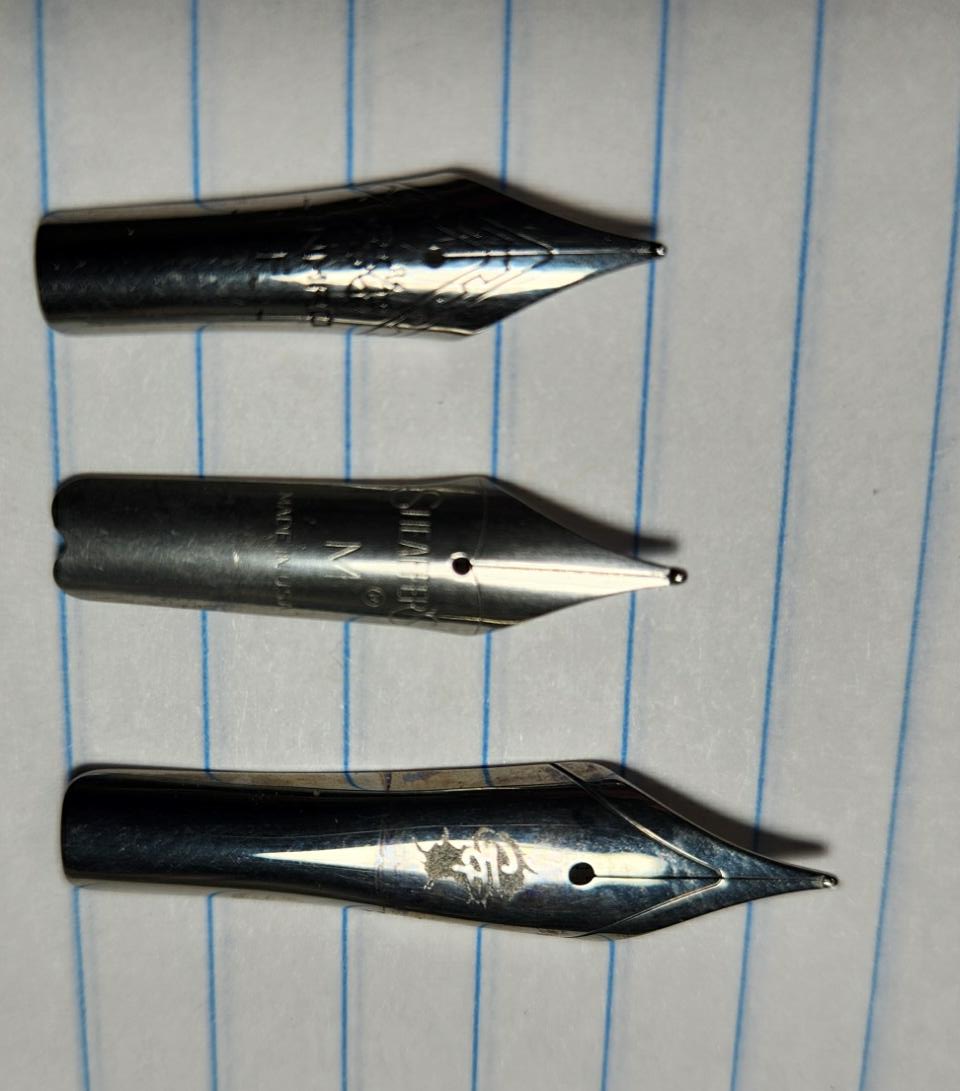I’ve become something of a fountain pen geek in the last several months. After not using a fountain pen since college when I had one of the ubiquitous Sheaffer student cartridge pens, I got away from it somehow. Then in a recent Christmas stocking I got a Pilot Varsity, which is a disposable fountain pen. I set it aside, then after a long time found it again and started using it. And I was hooked. Ink, nib, and paper.
I found Goulet Pens online, a happy source of pens, inks, and all such. As a newbie, I have stayed carefully at the inexpensive end of the pen buying market. There are pens out there that cost hundreds, even thousands of dollars. But in the shallow end of the pool, there are some really nice choices. Favorites so far have been Jin Hao 159 (replace the nib with a Goulet EF), Noodler’s Ahab, Noodler’s Konrad, and a nice Conklin All American (a brand endorsed by Mark Twain back in the day).
I swap nibs to get Fine or Extra Fine. My “handwriting” — I print in block caps that trend to smallish characters, which lose detail under Medium or Broad nibs.
I’ve also been working on a letter-for-letter copy of the Greek New Testament. That project begs for a fine nib, at least under my hand. Until yesterday, that project was under a Jin Hao 159 with a Goulet EF nib, and the Conklin All American EF.
Then yesterday, an inexpensive pen from China arrived. (Chinese sellers ship pens by Speedpak: Shanghai to my house in about three weeks). The Wing Sung 699 piston filler (not the 699 vacuum filler). Open it up, wash the nib and feed, ink it up … WOW: this could be my favorite pen ever.
(The 699 is a self-conscious knock-off of an expensive name-brand pen. That “cheap imitation” game is not uncommon among Chinese manufacturers, and the pen community is divided on whether this is a good thing or not. The manufacturers don’t actually counterfeit the pens, mislabeling them. So they all have their own name and model numbers. But side by side, the pens can be unmistakably similar.)
Well, the 699 has the things I have come to prefer. (1) A “demonstrator” model: the body is clear, showing the works and ink. (2) A “piston filler,” which has more capacity than the more common “cartridge converter” system. (3) #6 nib, which is a common nib size and easily swapped. (4) Not too small. For me, the old Sheaffer student cartridge pens, for example, are too small for long use comfortably. (5) Screw type cap. Many less-expensive pens have snap-on caps. (6) What else? I dunno.
What I do know is that I ordered this one with an EF nib, wondering if I’d have to swap it out for something from Goulet, my go-to nib store. But wow, this is theeeee finest EF nib I’ve ever used. I’ve never seen a fountain pen give such a nice, thin line, Plus it writes very smoothly, which is something you don’t always get in an inexpensive nib, especially at the F or EF end of the scale.
So. I may end up decommissioning both the 159 and the Conklin and using this 699 exclusively in the manuscript project.
Speaking of Chinese pens, the Kaigelu brand has a kangaroo logo, which, of course is what “kaigelu” means in Chinese. It’s not hard to imagine that when the Aussie guy said, “that’s a kangaroo,” the Chinese guy nodded and wrote down “kaigelu.” Of course the Aussie guy in his turn wrote down “kangaroo” when the aboriginal pointed at one and said, “gangurru.”





 Shakespeare’s Winters’s Tale is one of his late plays. I’ve long thought it remarkable that at the end of his writing career, Shakespeare produced two plays that offer studies in long labors of Repentance (Winter’s Tale) and Forgiveness (The Tempest).
Shakespeare’s Winters’s Tale is one of his late plays. I’ve long thought it remarkable that at the end of his writing career, Shakespeare produced two plays that offer studies in long labors of Repentance (Winter’s Tale) and Forgiveness (The Tempest).
 In the beginning, God told Adam not to eat from the tree of the knowledge of good and evil, telling him that in the day he did eat of it, “dying you shall die.” Or as most English translations say, “you shall surely die.”
In the beginning, God told Adam not to eat from the tree of the knowledge of good and evil, telling him that in the day he did eat of it, “dying you shall die.” Or as most English translations say, “you shall surely die.”




